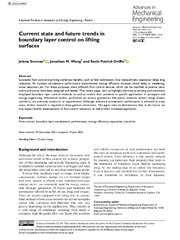Current state and future trends in boundary layer control on lifting surfaces
| dc.creator | Svorcan, Jelena | |
| dc.creator | Wang, Jonathan M. | |
| dc.creator | Griffin, Kevin Patrick | |
| dc.date.accessioned | 2022-09-19T19:28:57Z | |
| dc.date.available | 2022-09-19T19:28:57Z | |
| dc.date.issued | 2022 | |
| dc.identifier.issn | 1687-8132 | |
| dc.identifier.uri | https://machinery.mas.bg.ac.rs/handle/123456789/3724 | |
| dc.description.abstract | Successful flow control may bring numerous benefits, such as flow stabilization, flow reattachment, separation delay, drag reduction, lift increase, aerodynamic performance improvement, energy efficiency increase, shock delay or weakening, noise reduction, etc. For these purposes, many different flow control devices, which can be classified as passive, semi-active and active, have been designed and tested. This review paper aims to highlight the most promising and commonly employed boundary layer control methods as well as outline their potential in specific applications in aerospace and energy engineering. Referenced studies, performed on various geometries (flat plates, channels, airfoils, wings, blades, cylinders), are primarily numerical or experimental. Although enhanced aerodynamic performance is achieved in many cases, further research is required to draw general conclusions. This paper aims to demonstrate that, in the future, we may expect further developments of flow control actuators, as well as their increased application. | en |
| dc.publisher | Sage Publications Ltd, London | |
| dc.relation | info:eu-repo/grantAgreement/MESTD/inst-2020/200105/RS// | |
| dc.relation | National Defense Science and Engineering Graduate Fellowship | |
| dc.relation | Stanford Graduate Fellowship | |
| dc.relation | Advanced Simulation and Computing (ASC) program of the US Department of Energy's National Nuclear Security Administration (NNSA) via the PSAAP-III Center at Stanford [DE-NA0002373] | |
| dc.rights | openAccess | |
| dc.rights.uri | https://creativecommons.org/licenses/by/4.0/ | |
| dc.source | Advances in Mechanical Engineering | |
| dc.subject | transition | en |
| dc.subject | separation | en |
| dc.subject | Flow control | en |
| dc.subject | energy efficiency | en |
| dc.subject | boundary layer | en |
| dc.subject | aerodynamic performance | en |
| dc.title | Current state and future trends in boundary layer control on lifting surfaces | en |
| dc.type | article | |
| dc.rights.license | BY | |
| dc.citation.issue | 7 | |
| dc.citation.other | 14(7): - | |
| dc.citation.rank | M23~ | |
| dc.citation.volume | 14 | |
| dc.identifier.doi | 10.1177/16878132221112161 | |
| dc.identifier.fulltext | http://machinery.mas.bg.ac.rs/bitstream/id/2272/3721.pdf | |
| dc.identifier.scopus | 2-s2.0-85134344529 | |
| dc.identifier.wos | 000827548500001 | |
| dc.type.version | publishedVersion |


